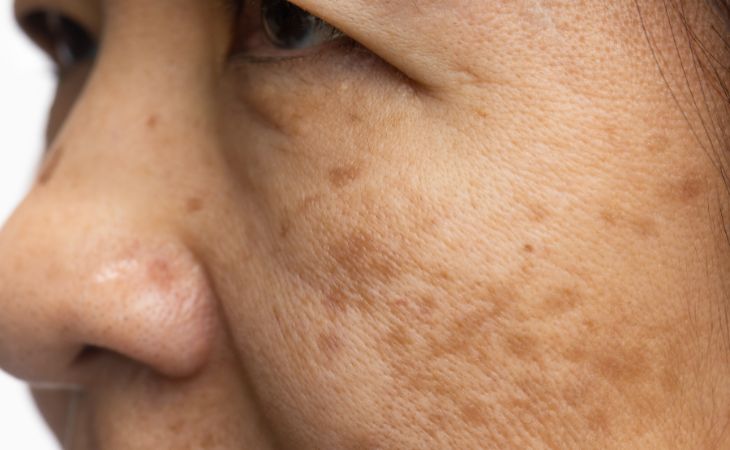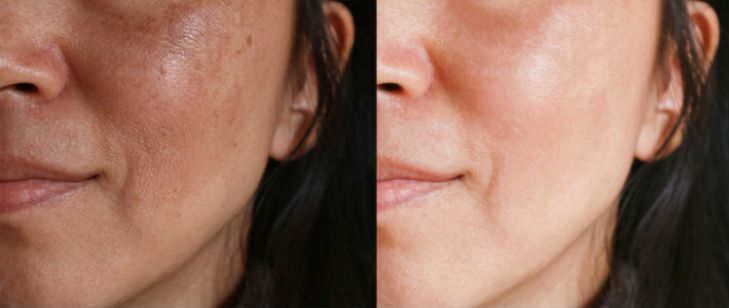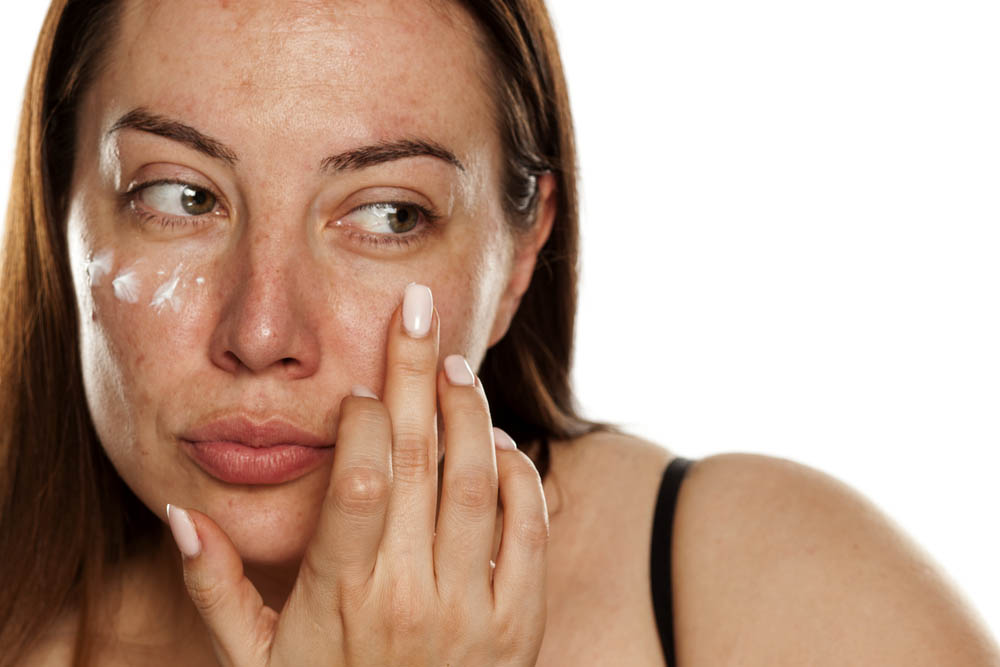Melasma Treatment: Symptoms and Diagnosis, and Treatment Options
Melasma is one of the most frustrating skin issues to treat. After spending countless hours in front of the mirror trying to cover this annoyingly persistent skin condition with various concealers, foundations and products without apparent results, don’t you wish you could just wave a magic wand and make it disappear? Does melasma make you feel self-conscious without make-up or when around others? Not excited about taking photos and left feeling disappointed that you can’t be carefree about your appearance? While melasma is very common and classified as a benign skin condition, it is damaging in many other ways.
Melasma’s impact reaches far beyond inconvenience; it can be very bothersome and affect how we view ourselves, our self-confidence, and our social life. But, there’s good news! You don’t have to just “live with it.” There are proven and effective treatment options and preventative measures you can take starting today! Here, we will review common causes of melasma, what to do to prevent it, and practical melasma treatment steps you can take to reduce discoloration symptoms dramatically.
Melasma, a form of hyperpigmentation that occurs primarily in women, can be particularly tricky to treat for many reasons — most notably because it is triggered and exacerbated by hormonal changes and UV exposure. Melasma’s hormonal component sets it apart from other forms of hyperpigmentation. However, the primary symptoms of both general hyperpigmentation and melasma are often similar: dark patches of discolored skin.
What is Melasma?
Melasma is a chronic – lasting three months or longer – skin disorder that causes light brown, dark brown and/or blue-gray patches of skin, typically on the face. Some people have melasma for years, some, their entire lives. Often starting during a woman’s reproductive years – between 20 and 40 years of age, individuals may notice flat patches or freckle-like spots. Referred to as the “mask of pregnancy“, melasma is known to appear as women undergo the hormonal changes of pregnancy, but it can also occur in other life cycles.

Who is at risk of Melasma?
People with darker skin (higher levels of melanin) and those who tan well tend to be affected by melasma more so than fair-skinned people. Additionally, women are far more likely to get melasma than men. In fact, about 90% of those with melasma are women, and about 10% are men. Pregnant women are the largest affected category, while those taking oral contraceptives or receiving treatment for hormonal imbalances also experience a higher risk.
Where does Melasma most commonly occur?
Melasma appears most commonly on the upper lip, cheeks, and forehead and can be found on the arms, neck, and back. In fact, melasma can affect every part of the skin exposed to sunlight. This is why sun protection is crucial for prevention, especially while treating melasma with the methods detailed below.
What causes Melasma?
As you know, our body’s largest organ is the skin – it makes up about one-seventh of your body weight! Acting as a protective barrier against cold, sun and heat, germs, moisture, toxic substances, injuries and more, the skin guards our bones, muscles, internal organs and other tissues from outside elements. In addition, our skin regulates body temperature and can feel sensations in order to survive potential harm.
Our skin is comprised of three main layers: the outer layer-epidermis, middle-dermis, and the deepest layer-subcutis. Our skin responds to light, heat, ultraviolet radiation, and hormonal stimulation by producing more melanin via melanocytes.
Therefore, the more our skin endures, and the less protected it is, the greater the chance of developing melasma.
What are the types of Melasma?
There are three types of melasma based on the depth of the pigment within the skin. A Wood’s lamp – a device that emits black light – determines how deep the pigment is. The three types are:
Epidermal: Epidermal (outer layer) melasma has a dark brown color and a well-defined border and may respond well to treatment.
Dermal: Dermal (middle layer) melasma has a light brown or bluish color with a blurry border. It typically doesn’t respond well to treatment.
Mixed Melasma: Mixed melasma, the most common of the three, has both bluish and brown patches, shows a mixed pattern and sometimes responds to treatment.
What causes Melasma?
The leading causes of melasma are:
- UVA and UVB radiation
- Heat such as sauna, hot showers, and hot weather
- Hormonal imbalances
- Inflammation
- Birth control
- Estrogen/Diethylstilbestrol
- Genetics
- Antiseizure medications
- Hypothyroidism
- LED Screens such as television, laptop, cell phone and tablet
- Pregnancy
- Makeup that causes a phototoxic reaction
- Phototoxic drugs such as antibiotics, diuretics, retinoids etc.
- Skincare products that irritate the skin.
How to make Melasma less noticeable?
If you have melasma, we recommend the following melasma treatment practices for achieving a more even skin tone:
Wear sunscreen daily. One of the most common melasma treatments is sun protection. Since sunlight triggers melasma, it is crucial to wear sunscreen daily, even when it’s cloudy. Constantly reapply after swimming or sweating. Choose a sunscreen that offers broad-spectrum protection, SPF 30 or more, and zinc oxide and/or titanium dioxide to physically limit the effects of the sun’s rays on your skin. Apply sunscreen 15 minutes before going outside and reapply at least every two hours.
Wear a wide-brimmed hat and sunglasses when you’re outside. Whenever possible, seek shade and wear protective clothing in addition to applying sunscreen.
Choose gentle skincare products. Choose non-irritating clinical-grade skincare products as products that irritate the skin may worsen melasma.
Avoid waxing. Waxing may cause skin inflammation which can worsen melasma. It is important to avoid waxing areas already affected by the condition.

How is Melasma treated?
Although melasma treatment can be lengthy and complex, we aim to make it as approachable and obtainable as possible by utilizing medicine’s newest and most effective modalities and creating a specific regimen just for you.
To create a melasma treatment plan, we must first determine the underlying cause. If the melasma did not clear up on its own (for example, after pregnancy), it might be permanent, or it could respond to diligent and ongoing treatment.
The melasma treatment lasts at least a few months. It includes corrective measures such as a clinical-grade prescription melasma skincare regimen, a series of laser, light-based or chemical peel procedures, and extensive protection from sunlight and other light sources. After the initial melasma treatments, a second treatment plan will be devised for you to maintain your results and prevent any melasma from returning.
Step 1: Melasma Prevention
The first step of melasma treatment is ensuring it doesn’t worsen. This means that a melasma patient has to avoid the sun, heat, tanning beds, LED screens, irritating soaps,, skincare, and birth control,, including hormones. In addition, we recommend a clinical-grade SPF of 30-50 applied every two hours when inside or out. Finally, a wide-brimmed hat is to be worn outside at all times, even in the shade. These steps may prevent your melasma from getting worse. We can be proactive by eliminating a recurrence or worsening of visible melasma, which is one of the best things you can do.
Step 2: Topical Medication
The second step of melasma treatment is our topical therapy. Topical therapy uses tyrosinase inhibitors which prevent new pigment formations by stopping the production of melanin (the dark color). The unique combination of hydroquinone, retinoids and other topical ingredients such as licorice extract, ascorbic, azelaic, or kojic acid, has had the best effect for Melasma treatment.
Hydroquinone is a standard prescription-only melasma treatment. It is applied to the skin twice daily for 4-6 months and will even out your skin tone. Usually, a several-month-long break is necessary between treatments, and a non-hydroquinone melasma topical is introduced.
Retinoids are often used in melasma treatment to increase the skin’s absorption of bleaching agents. They also help rid the skin of excess pigment by promoting cellular turnover. Retinoids are available in different strengths and formulations depending on your individual needs.

Step 3: Lasers/light therapy, peels and microdermabrasion
After the topical medication preconditions and prepares the skin, we proceed with procedures for melasma treatment which can include:
PicoLaser: These melasma treatments deliver extremely short pressure waves into the skin that shatter pigment into tiny particles, which are then absorbed and discarded by our immune system. The PicoLaser is a unique treatment option for melasma because it does not produce heat. Without heat, there is no risk of causing inflammation in the skin and, therefore no risk of triggering melasma. In addition, a series of these treatments performed 3-4 weeks apart can provide noticeable improvement of facial hyperpigmentation.
IPL Photorejuvenation: A great potential melasma treatment option for dermal and mixed forms is IPL Photorejuvenation. This scattered light energy technique offers a lower side effect profile than many other devices used to treat melasma.
Glycolic Acid Peels: Reduce the appearance of dark pigmentation by exfoliating the superficial layer of the skin. These peels involve little downtime or discomfort. A series of glycolic acid peels are most effective when combined with a series of microdermabrasion treatments every two weeks.
Microdermabrasion: This melasma treatment gently exfoliates the top layer of skin to reduce the appearance of hyperpigmentation. Most effective for melasma when performed in combination with a series of glycolic acid peels every two weeks.
Commitment and determination are necessary when reversing melasma as it slowly responds to treatment. A series of several melasma treatments will be required to reduce or altogether remove the pigment in affected areas. The length of the treatment will depend on the type of melasma, its location, and the patient’s ability to follow the doctor’s instructions diligently. Typically, the areas affected by melasma darken before they improve as they are brought up to shallower layers of the skin before being eliminated.
Melasma Treatment Programs at RevitalizeMaui
At RevitalizeMaui, we have developed several treatment programs for melasma, including PicoLaser, IPL photorejuvenation, topical prescription solutions, chemical peels and other modalities.
Once it is determined that you are a good candidate for our Melasma therapy, an ongoing Melasma Program will be recommended to suit your needs and further customized to maximize your chances of reducing your melasma symptoms. Following our science-backed protocol will take the guesswork out of this often lengthy process and will aim to deliver lasting results so that you can feel great about your skin again.
We will provide you with all of the information and support needed to guide you every step of the way. Call us to schedule your no-obligation consultation today!
Home
AESTHETICS & LONGEVITY
LONGEVITY MEDICINE
ABOUT
Home
AESTHETICS & LONGEVITY
LONGEVITY MEDICINE
- Mon - Fri : 09:00 AM - 4:00 PM
- 411 Huku Lii Pl. #102
- 808-419-7445

- YOUR LAST DIET EVER
- REQUEST APPOINTMENT
- CALL NOW
- Non-Surgical Body Contouring
- AESTHETICS
- LONGEVITY MEDICINE
- HGH PEPTIDE THERAPY
- BIOIDENTICAL HORMONE REPLACEMENT THERAPY
- FEMALE BIOIDENTICAL HORMONE REPLACEMENT THERAPY (BHRT) PROGRAMS
- TESTOSTERONE REPLACEMENT THERAPY FOR MEN
- MALE TESTOSTERONE REPLACEMENT THERAPY (TRT) PROGRAMS
- HORMONE PELLET THERAPY FOR MEN & WOMEN
- IV NUTRIENT THERAPY
- IM VITAMIN INJECTION BAR
- WEIGHT LOSS
- ABOUT
- NEW PATIENT REGISTRATION
- RVME REWARDS PROGRAM
-






